This list of aftermarket rails specifically addresses the Pint, Pint X (PX), XR (which would also include the Plus) and the GT. Swapping out rails is one of the bigger facelifts you can give a Onewheel. The ride of the board will absolutely change when completing this procedure. Its not a labor intensive project. Swapping out your own rails can be done under an hour of time. Tools needed: 1/8″ & 1/4″ Allen hex wrench for underside and Hub bolts and a Phillips screwdriver.
The Onewheel’s controller is programmed to the stock aluminum rails that come with the board. While the change in material doesn’t impact the controller, angled rails may change the way the controller senses ‘level’. It is to be noted that sometimes a tilt kit is purchased or a digital tilt programming is done to rebalance the controller.
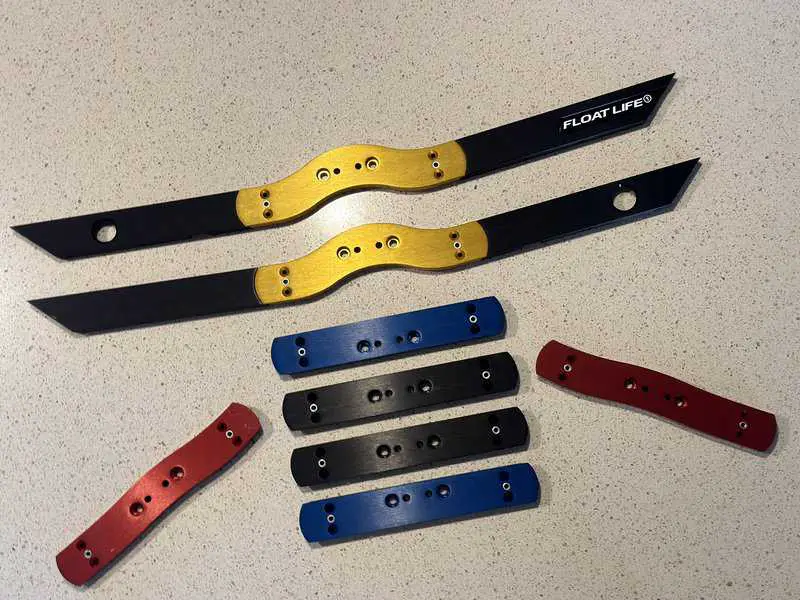
Most rails incorporate some angle, tilt or shortening of the rails. These variations add clearance and stability when riding. Some also have an intended lowering or raising of the deck for the same intentions. While many will claim that they are stronger than the stock rails, the stock rails are pretty tough and rarely are ever seen to break. More so than durability, focus on weight. Shedding some weight in a rail swap is always a bonus.
Onewheel GT Rail Line-up
Listed by popularity are the rail options for the Onewheel GT. Most rails attempt to solve the top-heaviness feel of the Onewheel GT and more importantly the overheating problems some riders have. The Onewheel GT stock rails weigh 1.4 lbs (0.6kg) per side, 2.8 lbs total (1.3kg). You wont shed much weight on rails but you can save a couple ounces.
#1 – Homebrew WTF Rails – The Float Life
The long anticipated Homebrew WTF Rails for the Onewheel GT have been taking the rail game by storm. The GT WTF’s come with some added perks such as hidden compartments for AirTags and some wire management.
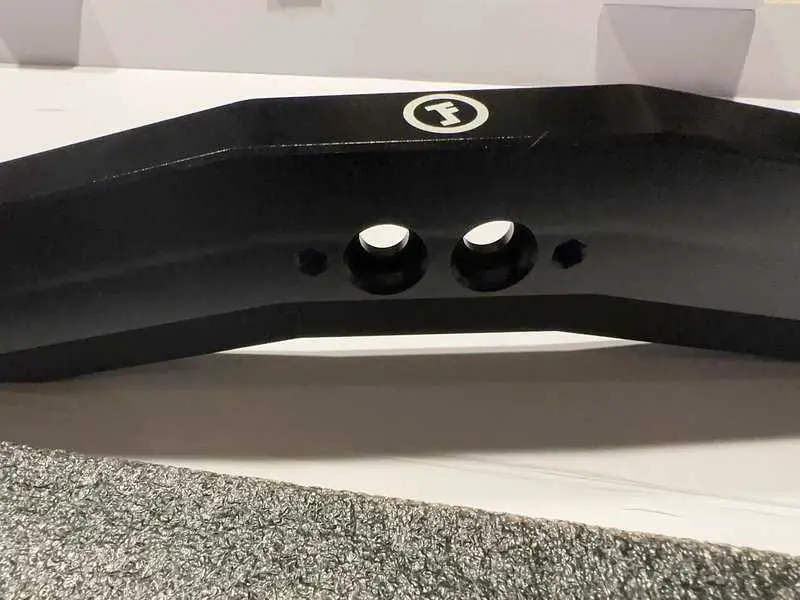
Pros:
- Same tried and true WTF stance from the XR now available on the GT
- No Loss of clearance with WTF rails
- 3° pitch to front and rear footpad for a locked in feel
- CNC rolled threads (no worries on stripped threads
- Lower center of gravity
- Optional Airtag holder and motor cable retention clips available
- Comes with 1/4-20 accessory attachment threads at hub for add-ons
- Comes in limited edition gold, black and raw
- Lighter than stock rails. 1.2 lbs each – 2.4lb rails (0.9kg)
Cons:
- Motor cable retention clips are an add-on
- Standard hardware (no titanium options)
- Not fender compatible (can use a split fender, fender deletes or the GT Drop Top Fender)
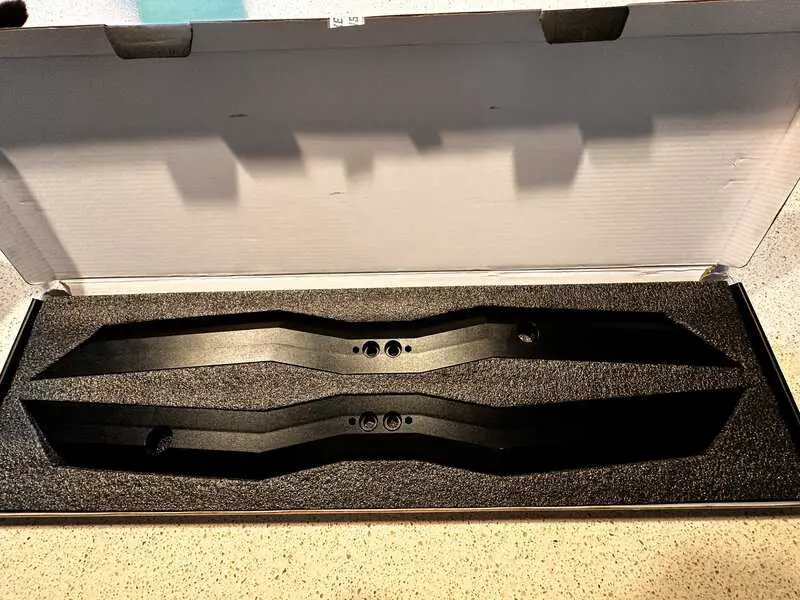
#2 – Homebrew Low Rider WTF Rails – The Float Life
The WTF rails from theFloatLife now offer standard, low rider and steep and deep. Low riders are going to give you the lowest possible stance while providing a subtle angle in the nose and tail. You wont need to worry one bit about stability, these rails ride low!
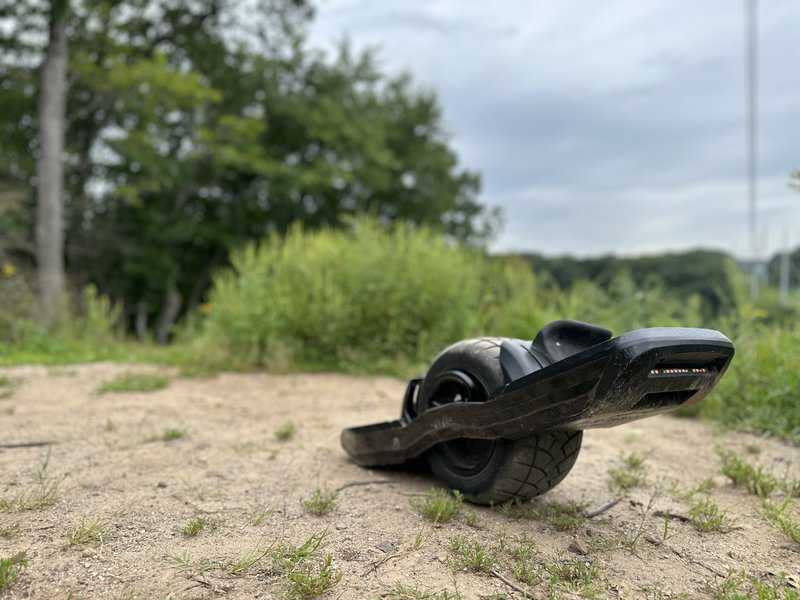
You probably will be noticing some curb slapping with these rails as the clearance is slightly less than stock. If you however are someone seeking to have that low, low center of gravity, then a set of lowriders will fit the bill.
#3 – Homebrew Steep & Deep WTF Rails – The Float Life
Steep and Deep are WTF rails but with a more aggressive angle allowing for a higher clearance for trail riding. Both nose and tail are angled 5° degrees (2° over the standard WTF’s). These rails offer the exact design so you can anticipate the same stoke only with a little more intense of an angle.
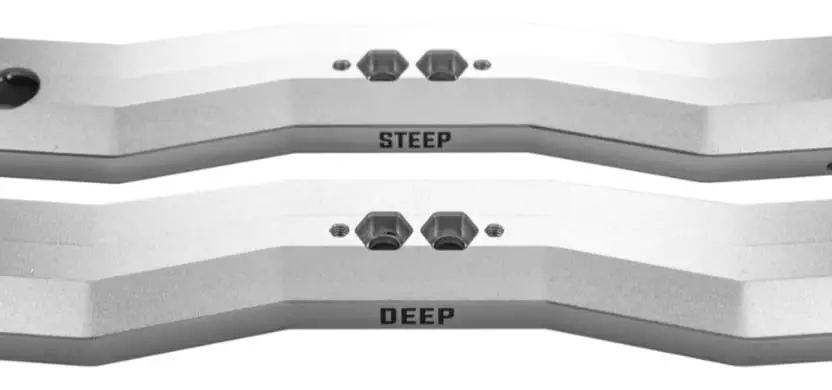
As the GT WTF’s, these come with the 1/4-20 auxiliary mounts for added gear on the rails. These stay lighter than stock rails and are ideal for the trail rider. (Weight is 1lb 5oz).
#3 – Mustache Rails by Mob Shoppe and Bob’s Stoke Shop
I mustache you a question. Do these rails improve the ride? What looks to be inspired by a bare-knuckle boxer’s mustache, the Mustache Rails offer a distinctive look to the Onewheel GT. At a $550 price point These rails give the GT a very unique look. These rails are a more subdued approach to modifying the ride. The pitch of the nose and tail is subtle as is the lower (axel hubs sit higher).
The intent with Mustache Rails is to lower your ride height which provides for increased stability. The pitch of the nose and tail is very slight which is intended to compensate for some clearance loss due to the lowering. Subtle differences to stock.
Pros:
- Lower center of gravity – 1/4″ lowering (0.25″ drop)
- Better stability
- Distinguished look
- Subtle angle to the tail ends
- Better heat dissipation
- Compatible with Flight Fins
- Anodized coloring
Cons:
- Slight loss of clearance
- Will require fender modifications
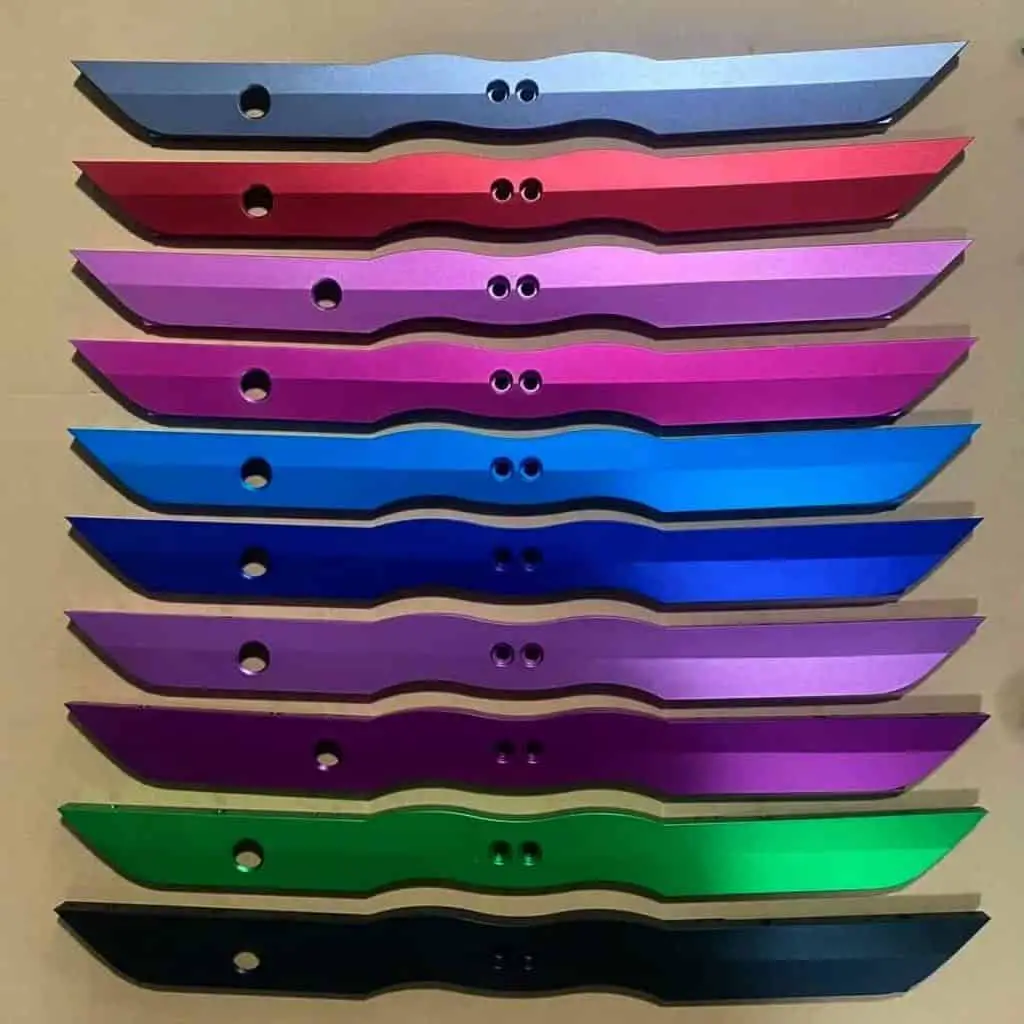
Check ’em out at the MobShoope.
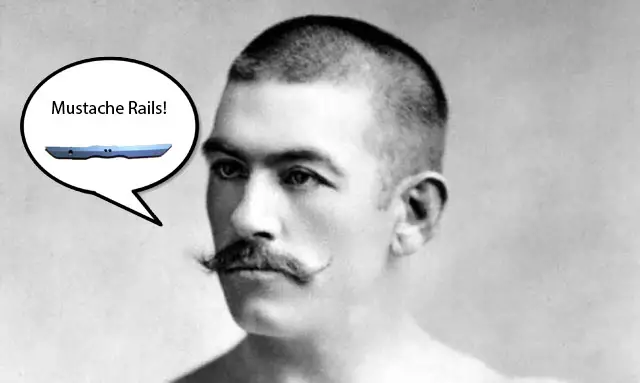
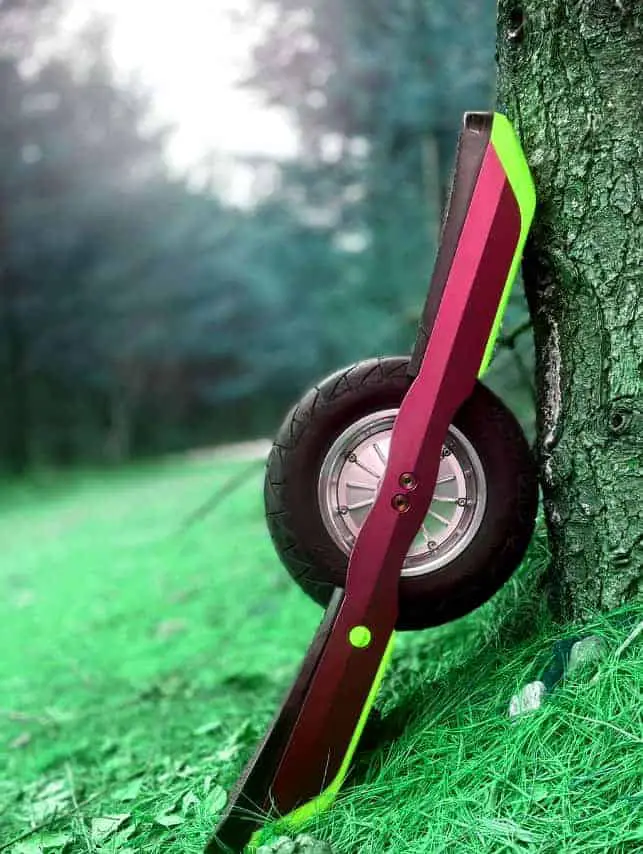
#4 – Lightning Rails by Mob Shop / Badgerwheel (now Floatlife)
I think of the Metallica album “Ride the Lightning” when I see Lightning rails. Ride the Lightning (rails)! This is an asymmetrical rail design that is designed to ride level while having an elevated tail. At around $599, the Lightning Rails are 1/2″ lower in the front of the controller so that it rides level and it has a 1/4″ lowering in the center of the rear footpad.
You will have a lowered stance due to the 1/4″ lowering. The tail end is also pitched 8° so that the tail clearance is similar to stock. Their name is the intent to their invention. They are fast as lightning and are setting records in competitions.
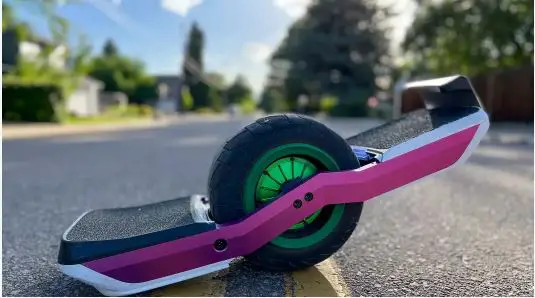
Pros:
- Lower center of gravity – 1/2″ lowering in front and 1/4″ in the rear
- Better heat dissipation
- Compatible with Flight Fins
- 7075 aluminum
- Anodized (Ano’)coloring
Cons:
- Slight loss of clearance
- Fenders not compatible (Flight Fin Fender works or need to purchase split fenders)
Visit Bobs Stoke Shop for Ordering!
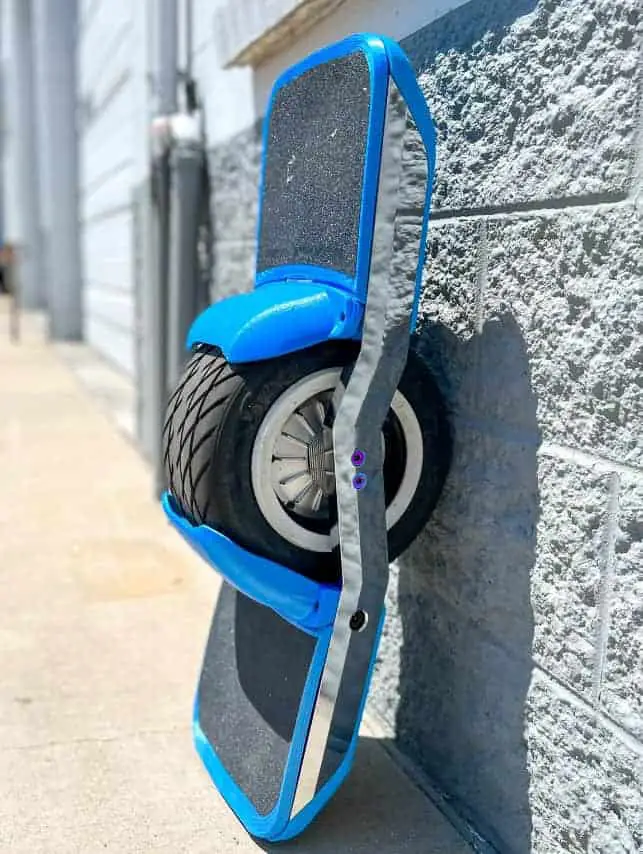
#5 – Saber Rails & Skeleton Rails – Tech-Rails
Where Lightning rails are level at the nose and angled up slightly in the rear, Saber Rails have a 3° angle upwards to the nose and tail. These rails come with adjustable axle carriers that have three height position placements (standard, lowered and raised). Saber Rails are crafted and designed for an overall improvement in control, stability and cooling without as much a bent toward racing.
Looking at these rails, they tend to come off less-exotic in design in comparison to Lightning and Mustache however
The Saber Rails are constantly improved by the skill and ingenuity of Matthew Shumaker who is the creator of Tech Rails

Saber Skeleton Rails & the Iconic Tech-Rails Truss Design
Saber Skeleton Rails are actually now a part of Techrails Switchblade line. This evolving rail as some are the Tech-Rails standard 7075 aluminum while some are custom ordered in titanium. According to Tech-Rails, the skeleton rails offer a 22% weight reduction over the stock rails. These rails sit at 27″ long and 3″ wide and over an inch thick!
Pros:
- 3° pitch to front and rear footpad for a locked in feel degree nose and tail tip-up for better control, comfort, and carving.
- Superior heat dissipation due to air flow
- Compatible with Flight Fins
- 7075 aluminum
- CNC machined finned aluminum axle carriers that clamp around the axle for increased rigidity, and heat dissipation.
- Twice as strong over stock rails
Cons:
- Price (riding Tech-rails is a premium product). Depending on rail, material, anodizing, titanium hardware these rails can range from $400 to over $1000
- Fenders require modification
- Trail debris can get into the truss design
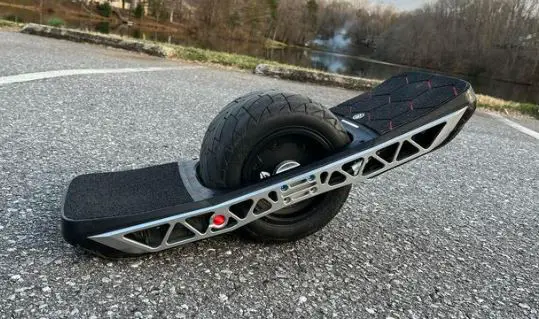
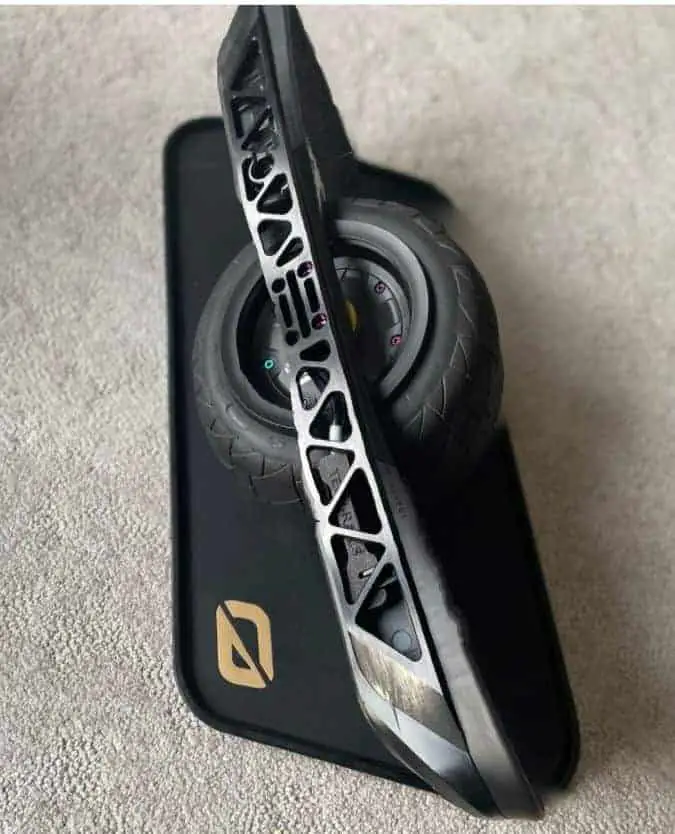
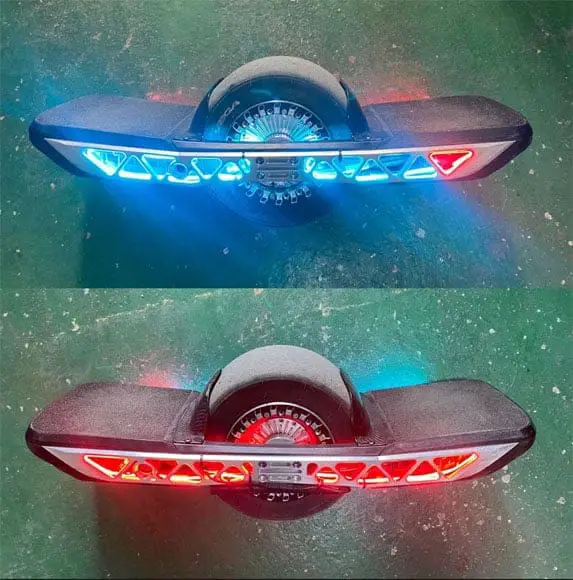
Tech-rails is constantly innovating their designs with Tron-like / futuristic influences. You can’t ignore these rails. Again, these rails do come at a cost however the material and the machining involved, the quality is unrivaled.
It is a challenge to say which rails are the better rails. In my opinion, the reason Tech-rails are less-popular is due to price. Same as a Porsche. Everyone would have one if the price dropped, but would Porsche want that for their brand? Their exclusive as is Tech Rails!
#6 – 357 Rails – Tech Rails
A 357 Magnum revolver sets the stage for these rails. Of course when it to a 357 revolver the number is in reference to the bullet diameter. Here with Tech-Rails however, the numbers do have meaning. The 357 stands for 3.5 degree tilt in the nose and a 7 degree in the rear. This is somewhat similar to 7 second rails except the nose has an upward angle and the nose and tail are equal lengths.
The advantage of a more aggressive angle on the tail is for more clearance when lifting the nose end of the Onewheel. 357’s do come standard and ‘skeleton’ for the obvious advantage of shedding some weight but also just to have that iconic truss design show. 357’s come with four height positions like the Saber Rails. They also include are axle carriers and full titanium axle bolts. Price will vary as Tech-Rails is often order-to-spec. These rails typically start $795+.
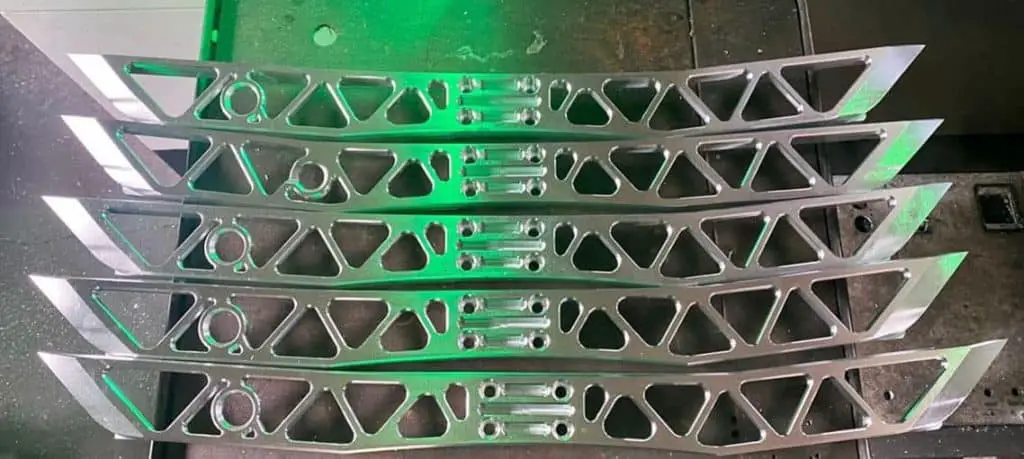
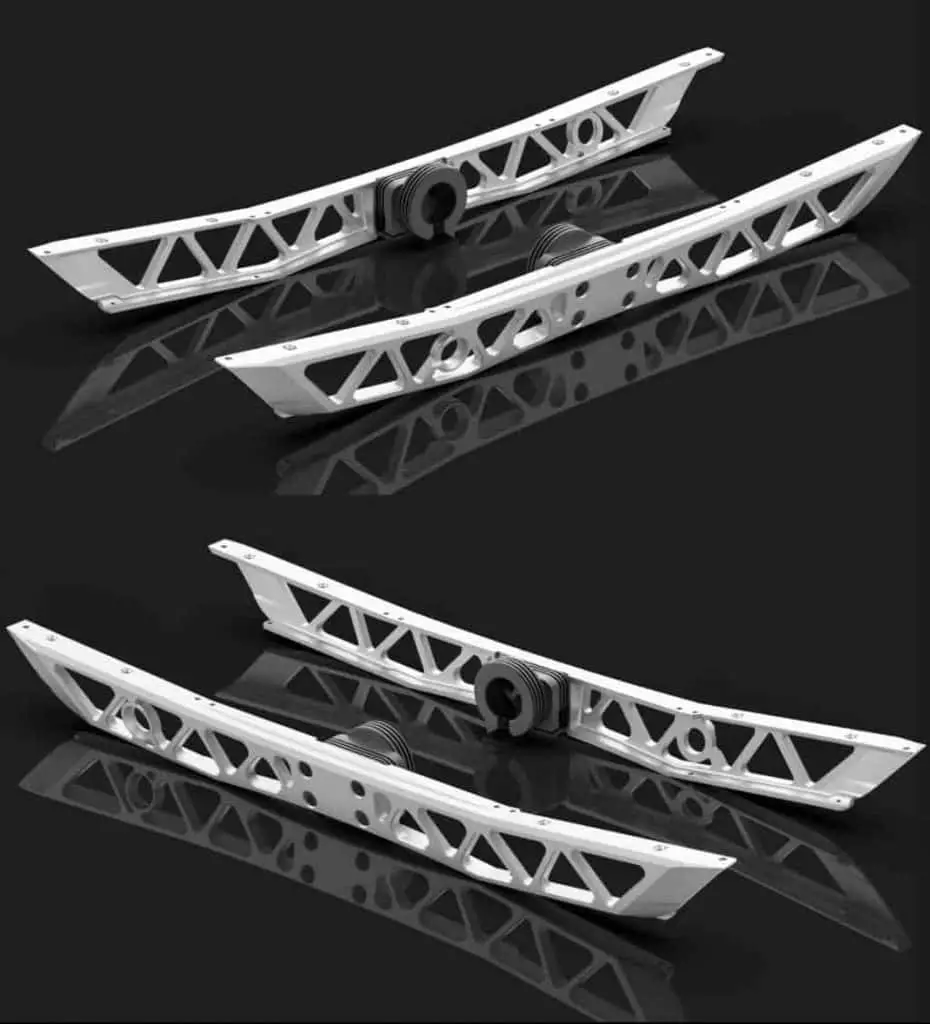
Pros:
- 3.5° degree nose-up for better control, comfort, and carving.
- Superior heat dissipation due to air flow
- Compatible with Flight Fins
- 7075 aluminum (Titanium option available)
- CNC machined finned aluminum axle carriers that clamp around the axle for increased rigidity, and heat dissipation.
- Four height configurations
- Twice as strong over stock rails
- Weight shedding over 20% over stock rails with Skeleton version
- Higher tail offers superior clearance on trails.
Cons:
- Price (riding Tech-rails is a premium product). Depending on rail, material, anodizing, titanium hardware these rails can range from $400 to over $1000
- Fenders require modification
Visit Tech-Rails for more details or check out their social pages.
As of now, the GT rail line-up continues to evolve. We yet to have been graced with GT Varials or Switchblades for that matter. Will they be available for the GT? One rail to look out for is the Float Life’s ‘Steep and Deep’ rails which are an exaggerated version of the WTF’s. These are focused on climbing steeper hills and able to bomb down deeper declines.
Any GT rail system you go with is going to help with heat dissipation. The GT does have an issue trapping heat within the rails. Unless you sand off the stock paint, an aftermarket rail is the way to go.
#7 – Katana Rails – Tech Rails
Katana rails are a variant of the 357 rails. These have a 3.5 degree nose pitch and a 7 degree pitch to the tail. They offer two height stances similar to the 357’s. These essentially are a smooth (smooth like a Katana blade) version of the original 357’s. Trading a little added weight for the beauty.
Onewheel XR Rail Line-up
Again listed by popularity, here are the rail options for the Onewheel XR. While the XR is a discontinued platform, The versatility for the use on a VESC board or just for the love of the XR over a GT, the XR boards are still a heavy presence in the Onewheel community.
Stock rails for reference weigh 2lbs (0.9kg)
#1 – Homebrew WTF Rails – The Float Life
When the WTF’s hit the market, the reaction was ‘What the F…’? WTF (actually standing for ‘Wow They’re Fast’) hit the market and was one of the first produced aftermarket rails for the Onewheel to offer an angled nose and tail design.
Several pro riders at Dirt Surferz compete with WTF’s. This is another incredible rail meant for trail riding as they provide a lower center of gravity which immensely increases stability. The angled nose and tails compensate for zero loss in clearance.
In a way, you are pushed to the center of the board keeping you always stable and helps with wobbles.
Pros:
- Made from 7075 aluminum (strong as steel but lighter weight). 2.1lbs (0.95kg)
- Two levels of anodizing.
- Improved threads (say good bye to stripped threads on the rails) 400 series stainless steel inserts.
- Improved control and stability
- lower center of gravity
- Flight Fins compatible
Cons:
- Noticeable difference when riding in reverse.
- May require a Tilt Kit or a digital tilt modification (nRF Connect app).
- May require custom shaping to achieve a similar feel as stock rails (nose slightly elevated)
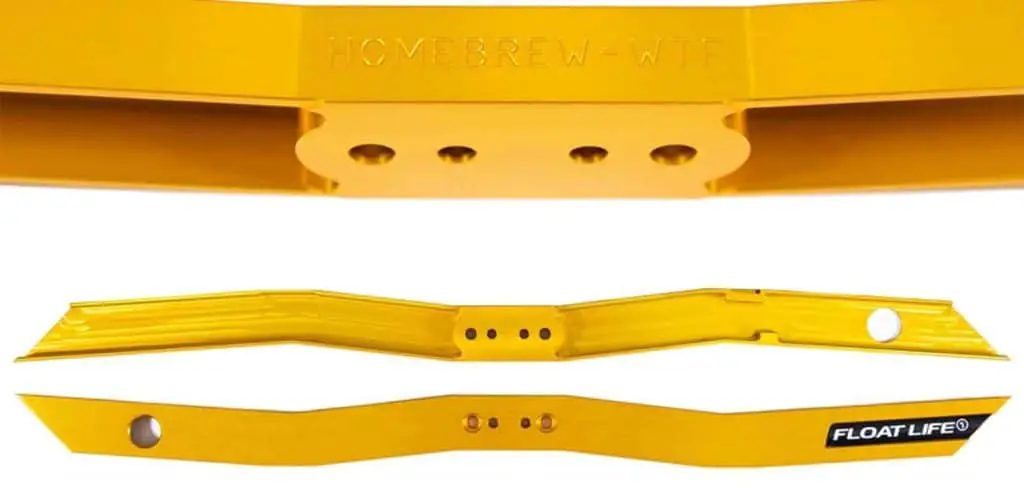
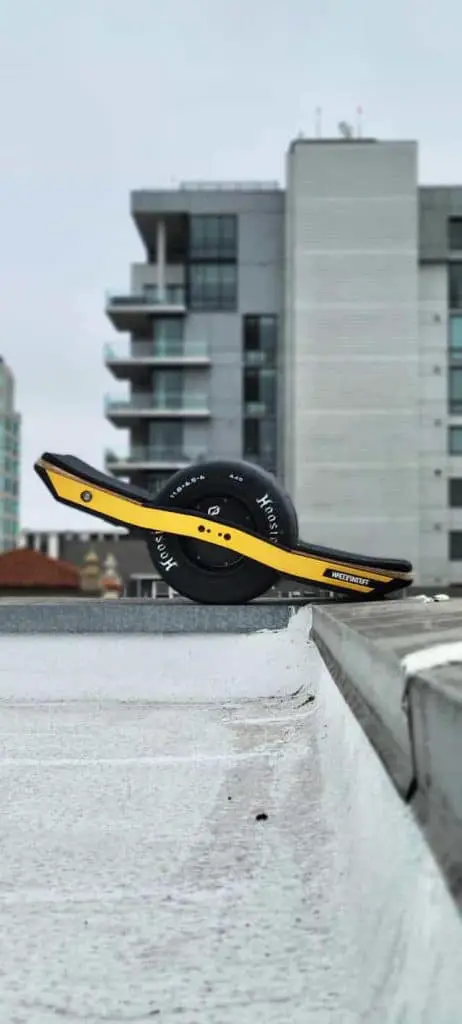
#2 – Homebrew (Standard and Growler) Rails – The Float Life
What is a Onewheel Growler? Well simply put its a name used to describe a board that is between a Pint and XR. Think of beers. You drink a pint at the bar, you may buy a growler to take home. A growler build consists of shortened rails and a Pint sized tire. The added perk here is for more clearance and a torque.
Same exact quality as the WTF rails however with the straight homebrews, they come shorter if you’re looking for a growler build. With a shorter rail, when pulling back on the tail, you get more added clearance. These are great for stunt riding as well as making a board feel somewhere between a Pint and XR.
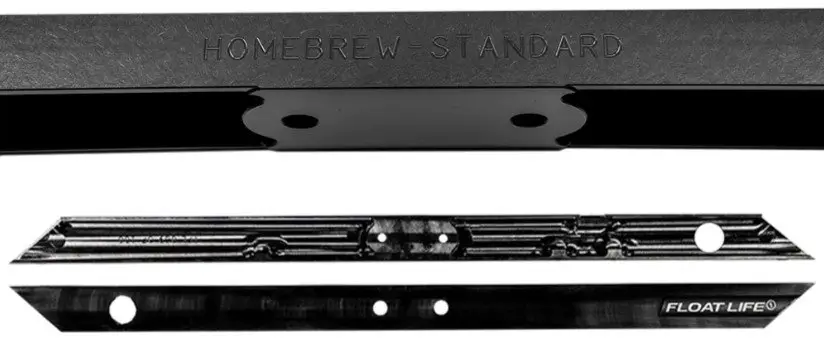
Pros:
- Made from 7075 aluminum (strong as steel but lighter weight).
- Type 2 anodizing.
- Improved threads (say good bye to stripped threads on the rails) 400 series stainless steel inserts.
- Improved control and stability
- lower center of gravity
- Flight Fins compatible
Cons:
- Noticeable difference when riding in reverse.
- May require a Tilt Kit or a digital tilt modification (nRF Connect app).
- May require custom shaping to achieve a similar feel as stock rails (nose slightly elevated)
#3 – Varials – The Float Life
This is a one of a kind modular system in which the rider replaces the center portions of a six piece rail to provide for lift, lowering or an angle ride. Varials are offered with four quarter panels (ends of both rails) and a center portion (Center Steez Straights for straight rail riding, Hi & Lo – lifting or lowering, Bodhi Pro Center Steez for lifting or lowering and for a slight angled ride [1.66 and 1.42 degrees] *Limited edition, Straights for a stock ride, FAF (A.K.A. Fast as F*ck) has a more notable angled ride than the WTF’s, and WTF for a similar WTF rail ride)
Pros:
- Flight Fins compatible
- Anodized paint.
- Built with 7075 aluminum.
- 400 series stainless steel thread inserts (say good bye to stripped threads on the rails).
- Improved control and stability
- Lower center of gravity
- Ride lifting and lowering capable
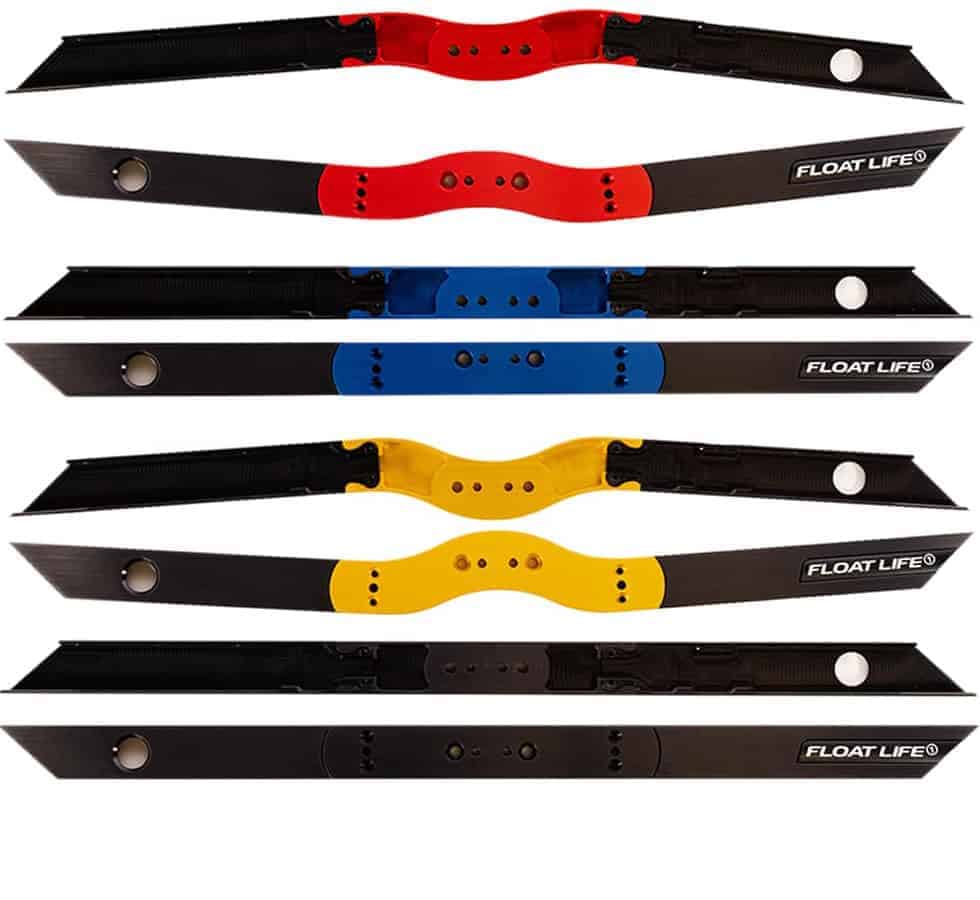
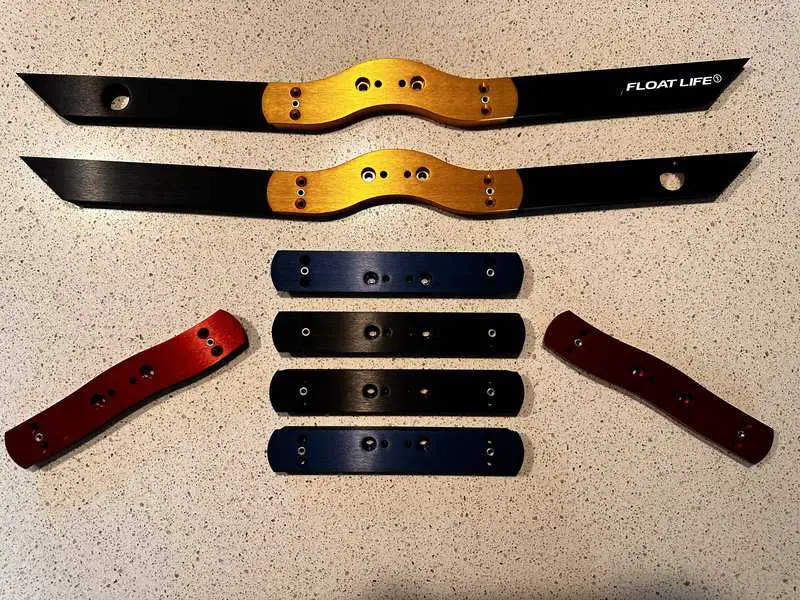
Cons:
- Noticeable difference when riding in reverse. If using an angled center.
- May require a Tilt Kit or a digital tilt modification (nRF Connect app).
- May require custom shaping to achieve a similar feel as stock rails (nose slightly elevated)
- Fenders may require mods or may not fit (depending on angle)
#4 -Homebrew WTF – BTG – Extended Rails
If you are a taller rider and are seeking a longer board, the WTF / BTG Extended rails fit the bill. The BTG (Big Tire Gang) is made so that a larger diameter tire can fit within the XR wheel well. Larger tires are great for trails. That added sidewall gives you the suspension needed on chunky trail.

Being a WTF profile, you get all the benefits of the original WTF’s but with a little more stability from the longer footprint and the ability to pop in a larger tire. That added sidewall makes a difference.
#5 – TailRails (7 Second Rails) – The Float Life
FlightFins and Badgerwheel (now sold by the Float Life) did a collaboration in creating their “Seven Second Rails” after both Brenden Schurmeier and Kyle Hanson crushed their top Strava times by seven seconds on the highly competitive Whoops trail in Los Angeles.
These rails are intended for downhill speed as you can lift the nose up enough on some intense downhill areas without having the tail dragging.
Pros:
- Ability to ride these in reverse for intense hill climbs.
- Affordable rail (Starts under $200)
- Flight Fins compatible
Cons:
- Noticeable difference when riding in reverse.
- Different feel when riding.
- May require custom shaping.
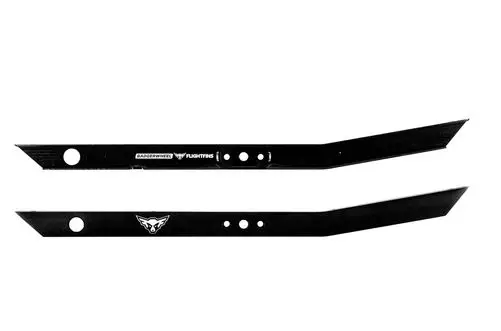
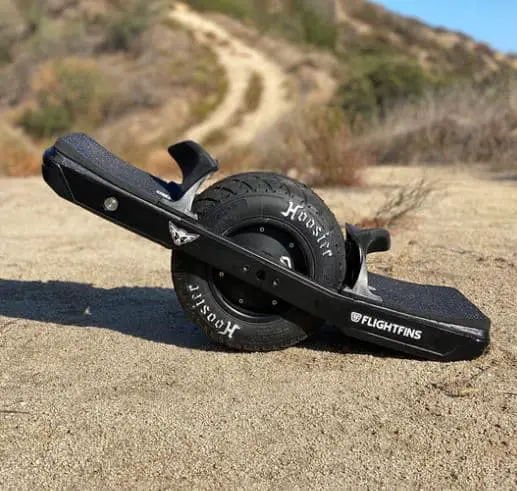
#6 – Switchblades & Skeleton Switchblades – Tech-Rails
A personal favorite of mine in XR rail line-up is the Switch Blades by tech-Rails. These rails are far more customizable than any rail on the market. The Switchblades have gone through several redesigns from a solid rail with an embedded truss design, to a “skeleton” style keeping that iconic look. The Switch blades are able to be customized at several angles for the nose and tail. You can made it asymmetrical like Tailrails if you choose. There is no end to the possible combinations with these rails. They come with couplings to adjust the height as well.
Offered in many matching and mismatching color schemes, the Switchblades are the leading rails in custom appeal. Tech rails offers titanium hardware to show off the Onewheel even more-so.
Pros:
- Kiil Guard suspension compatible
- Flight Fins compatible
- Anodized paint.
- Built with 7075 Aluminum.
- Optional titanium hardware.
- Stainless steel thread inserts (say good bye to stripped threads on the rails).
- Improved control and stability.
- lower center of gravity
- Ride lifting and lowering capable.
Cons:
- Heavy rails. Weight is 3.8lbs (1.72kg)
- Noticeable difference when riding in reverse.
- May require a Tilt Kit or a digital tilt modification (nRF Connect app).
- May require custom shaping to achieve a similar feel as stock rails (nose slightly elevated)
- Fenders may require mods or may not fit (depending on angle)
- Price – less affordable than the Varials (riding Tech-rails is a premium product). Depending on rail, material, anodizing, titanium hardware these rails can range from $700 to over $1000
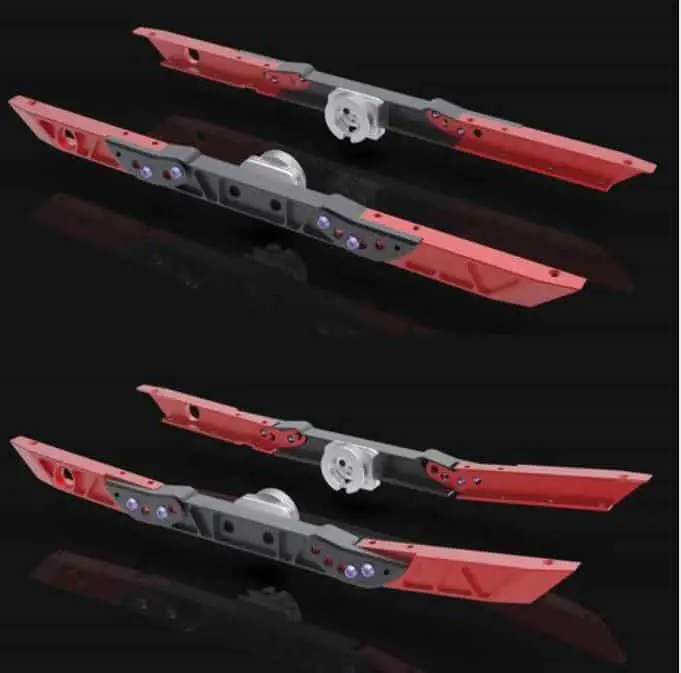
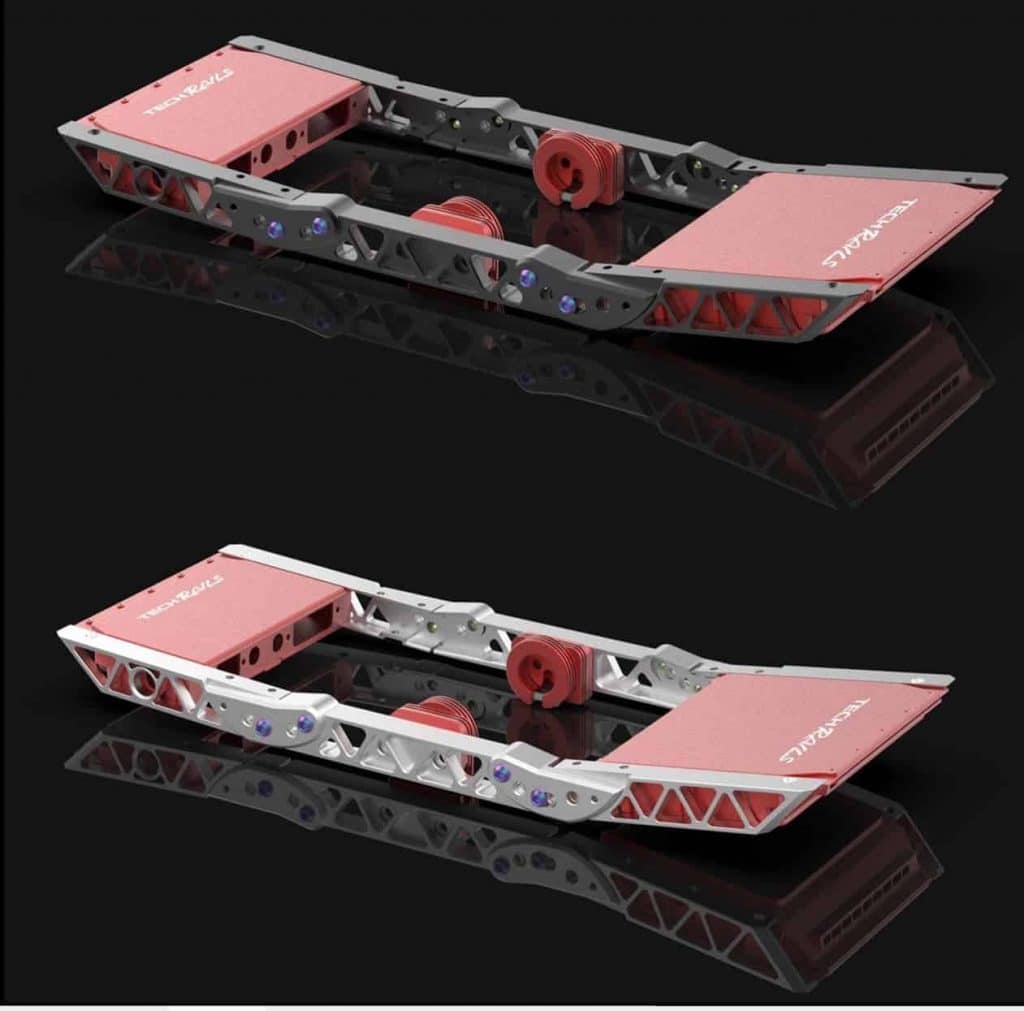
#7 Fungineers – Thunder Rails
Thunder rails are probably the best choice for DIY enthusiasts and Onewheel XR owners. These rails come with a desirable “W-shaped design” and built in lifting and lowering hub settings.
Pros:
- Made from 7075 Aluminum / Fixed rail for ultimate strength
- 3 built in ride heights
- Compatible with Flight Fins
- Affordable – ideal for VESC conversion or DIY build.
Cons:
- Fenders compatibility issues
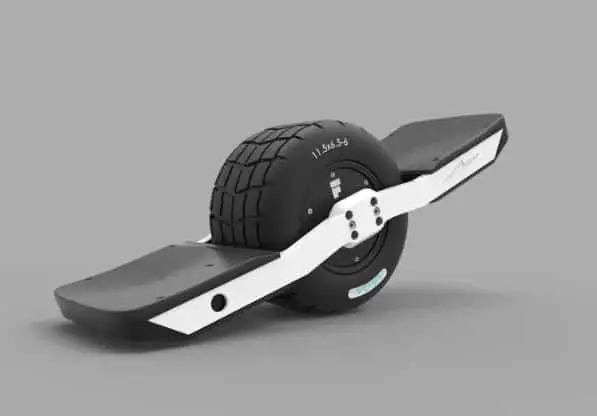
#8 -X10 Rails – Fungineers
Fungineers make rails for the DIY Onewheel rider. Whether you are VESC’ing or looking for a new set of rails for your XR, Fungineers X10 Rails have a unique take on an angled rail.
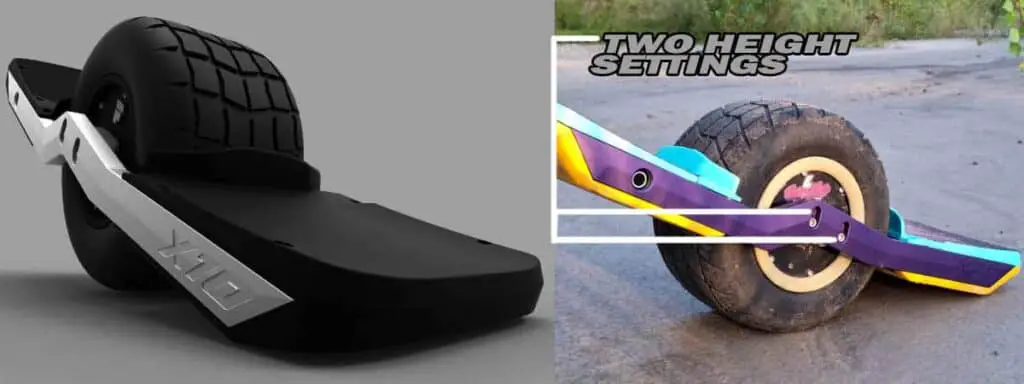
They do initially come across as ‘Lightning Rails’ which are made for the Onewheel GT. These rails add all the perks of Lightning rails but they have a built in height adjustment system.
They offer a 7 degree pitch in the front and a 3 degree angled tail (with a VESC controller, more options are available) but what makes these different is that these are extended rails that allow for a larger tire (up to 12 inch tire).
Pint & Pint X (PX) Rail Line-up
Aftermarket Pint rails are not as common to see however they are out there. Tech-Rails is taking the lead on building out some beautiful rails for the Pint model Onewheels. Now with Pint X being a perfectly legit range board, lets hope more trail-inspired rails will come to market. Here it is:
#1 Tech-Rails – Truss Design Rails for Pint
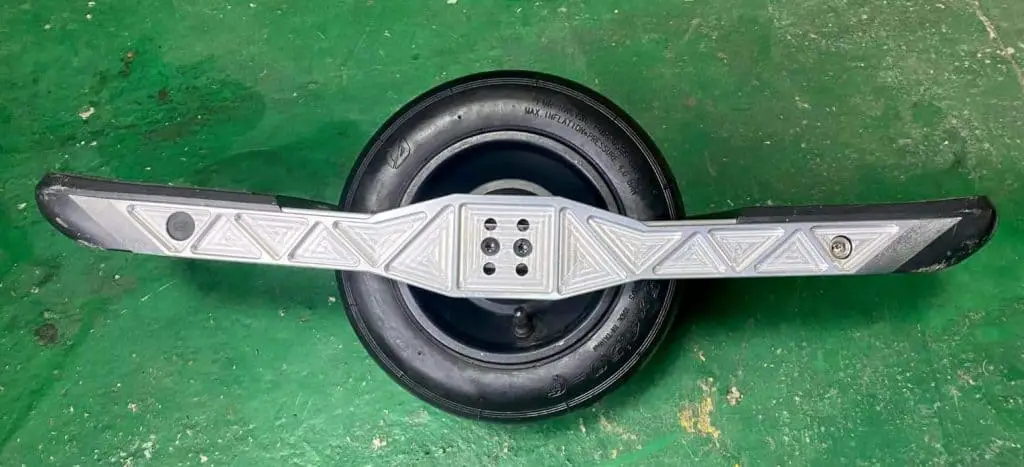
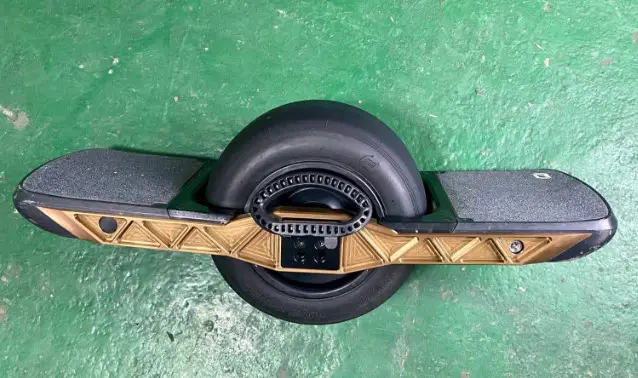
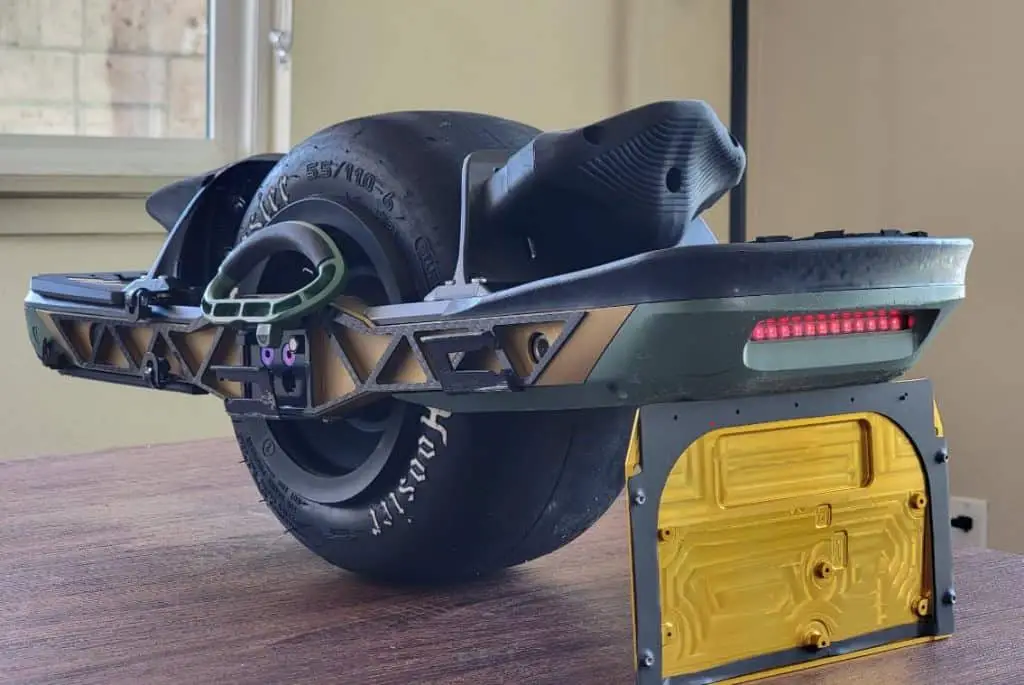
Tech-Rails started out with making rails that had height adjustment options (generation 1) built into the rails. Since then their later models focus on axle carriers to do the lifting and lowering.
Tech rails was the company to offer the truss design into the rails. Floatwheel ADV and ADV Pro has taken much of this concept to their lineup unfortunately.
The Pint Tech Rails come as ordered. As stated above, much of Tech Rails business model is ordering to spec. These rails can be electroplated for an additional cost. It is unknown if anodizing is available on this rail. These rails start at around the $300 to $400 range depending on hardware and coloring.
Pros:
- Twice as strong rail over stock
- Compatible with Fenders and Flight Fins
- Stainless steel threaded inserts
Cons:
- Heavier rail over stock.
- Removing charging cord is challenging due to the design.
#2 – Switchblades & Skeleton Switchblades by Tech Rails
Switchblades has been an evolving rail design. They started with height adjustments on the side rails and have gone through a couple redesigns with that however now, they are typically sold with a CNC axle carrier that does the job.
The same truss design remains on their Switchblade line-up. And as they always improve their products, the Skeleton Series is available for Switchblades. These cut the fat making them lighter.
All Techrails offer titanium hardware which can make an epic contrast appeal to the eye. Mismatching centers and rail arms is common with Switchblades. These rails operate similar to the XR models.
Pros:
- Flight Fins compatible
- Anodized paint.
- Built with 7075 Aluminum.
- Optional titanium hardware.
- Stainless steel thread inserts (say good bye to stripped threads on the rails).
- Improved control and stability.
- lower center of gravity
- Ride lifting and lowering capable.
Cons:
- Noticeable difference when riding in reverse. (if pads are angled upward).
- May require a Tilt Kit or a digital tilt modification (nRF Connect app).
- May require custom shaping to achieve a similar feel as stock rails (nose slightly elevated)
- Fenders may require mods or may not fit (depending on angle)
- Price – (riding Tech-rails is a premium product). Depending on rail, material, anodizing, titanium hardware these rails can range from $700 to over $1000
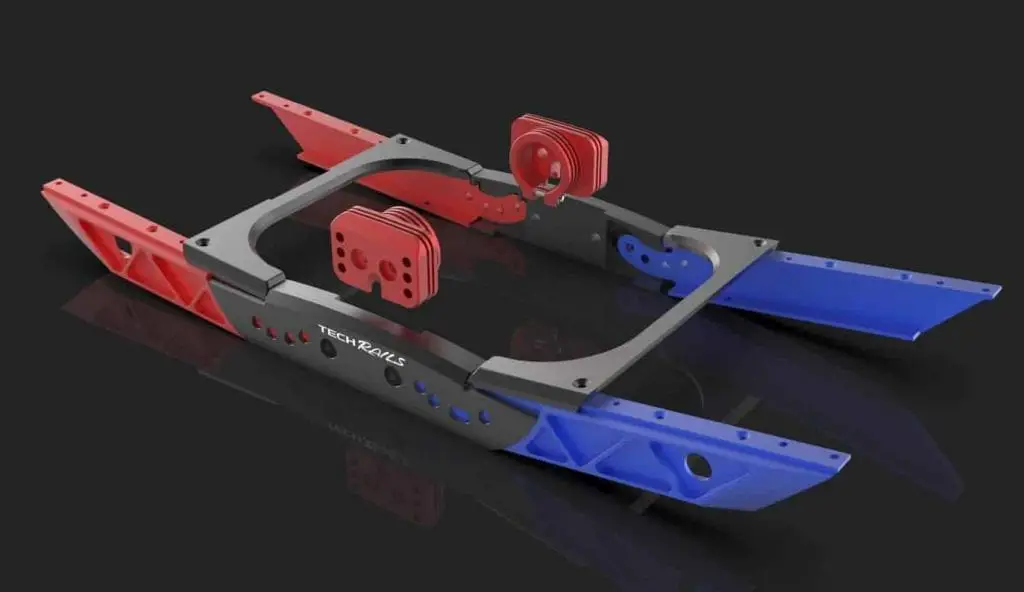
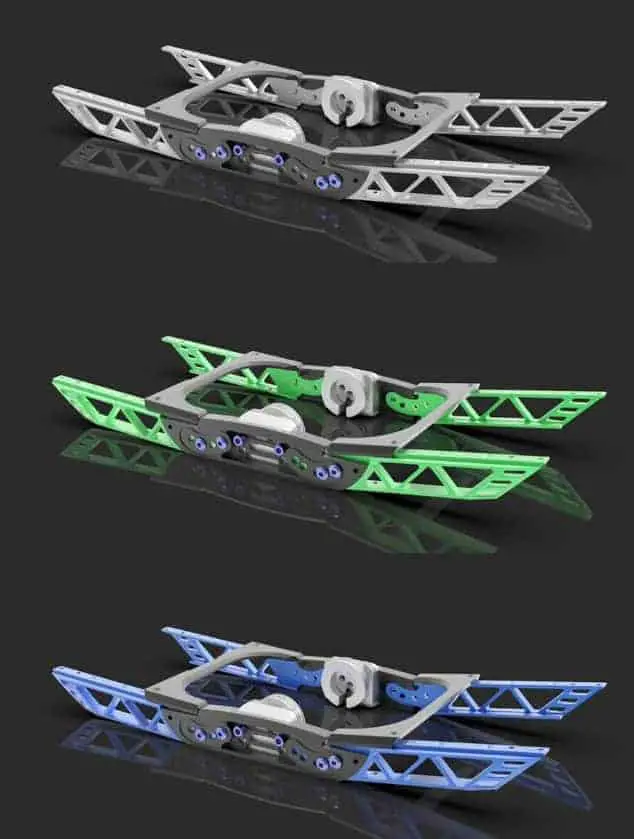
#3 – Stiletto Rails – Tech Rails
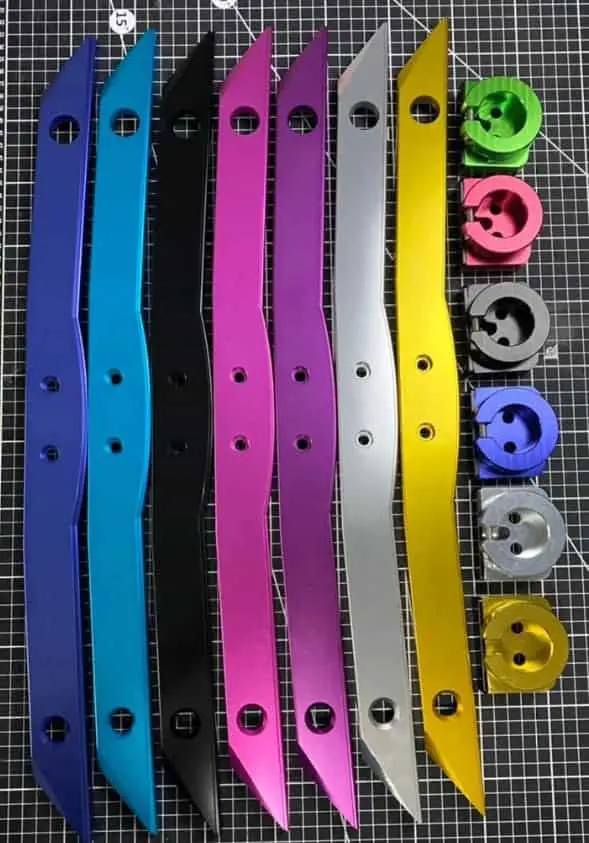
The Stiletto is a smooth satin-like finish giving the rider a pitch to the nose and tail with a slight lowered position. The Stiletto Rails provide a 3 degree nose and tail tip up for a more locked-in and stable ride.
They are CNC machined from solid Billet aluminum for high strength and light weight and come in brilliant anodized colors (better for heat dissipation compared to stock painted rails).
These rails also comes with adjustable height axle carriers! They provide for better contact to the motor for cooling as well as three height positions for a complete custom ride.
Pros:
- 3 degree nose and tail tip-up for better control and locked-in feeling
- Can raise .4″ or lower .4″ with axle carriers
- Superior heat dissipation due to hub contact
- Compatible with Flight Fins
- CNC machined finned aluminum axle carriers that clamp around the axle for increased rigidity, and heat dissipation.
Cons:
- Price (riding Tech-rails is a premium product). Depending on rail, material, anodizing, titanium hardware these rails can range from $400 to over $1000
- Fenders require modification
#4 – Dagger Pint Rails – Tech Rails
Sharp looking like a true dagger, the Dagger Rails have a smooth knife blade look that kills. This is the most affordable rail made by Tech Rails. Coming in under $300, there is simplistic beauty in them. No axle carriers. No height adjustments. just a refined looking 3 & 3 tilted rail set.
Essentially with the 3° and 3°, these are similar to the Saber Rails, but just for the Pint and a little sharper looking… Ouch!
Pros:
- 3 degree nose and tail tip-up for better control and locked-in feeling
- Improved over stock heat dissipation due to exposed rail (No paint. Coloring is anodized.)
- Compatible with Flight Fins
- CNC machined finned aluminum axle carriers that clamp around the axle for increased rigidity, and heat dissipation.
Cons:
- Fenders require modification.
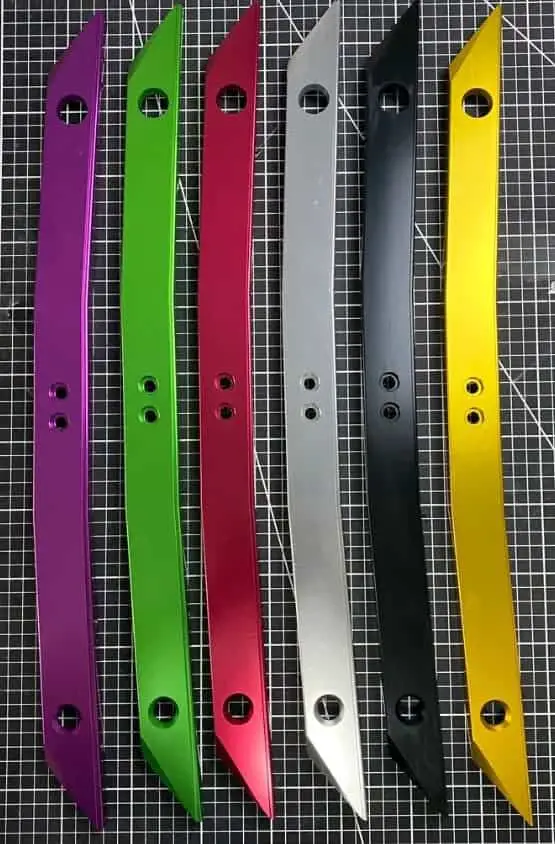
#5 – WTF Rails for Pint and Pint X – The Float Life
WTF Rails (Wow They’re Fast) for the Pint (X) is honestly a total game changer for the Pint. Over the time, this platform is being more respected as a freestyle and trail board. With WTF’s as an option for the Pint, the Pint is carving its own space in the Onewheel community.
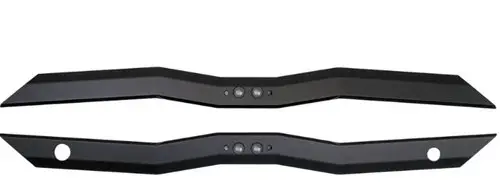
Pros:
- Same amazing WTF design for the Pint as prior XR rail models
- No loss in clearance
- CNC roll tapped threads
- 3° pitch to front and rear footpad for a locked in feel
- Comes with 1/4-20 accessory attachment threads at hub for add-ons
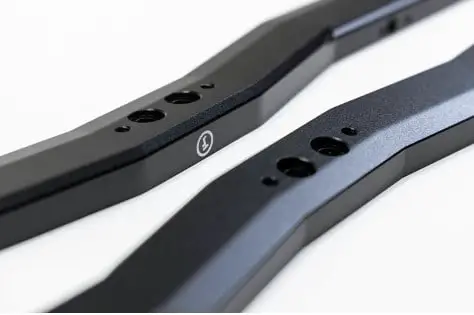
Cons:
- Price is relatively steep (currently $420.69)
- Fenders not compatible
Summary
Remember that with a rail swap, you will void the warranty (if one is remaining) as removing the rails means removing the tamper sticker affixed over the rail screws. it’s my opinion that rails do hold more value than most (if not all) aftermarket modification completed to the board. Used rails in good shape can render anywhere from 50% to 75% of their original cost. Sometimes, depending on availability, used rails can render more than the price paid.
Get out there and try a new rail set. So just know that aftermarket rails will hold more value than most if not all other aftermarket mods you complete to your board. Just try to keep them clean. If the rail distributer does not offer a rail protection solution (such as rail guards, side kicks, etc) and you are looking for it, then check Etsy. Often there are people who craft custom covers on that site. Get customized and float on my friend!
F.A.Q.’s
WTF’s are available for GT and the Pint lines as of April 2023.
The Switchblades offer a multitude of combinations regarding tilt of the nose and tail, lowering or raising of the board itself. If you are seeking a rail that can be changed on the fly, try Switchblades. The Float Life does have adjustable rails with a clever concept. They work by changing the center rail for a preset 5 (including a limited Bodhi version) stances.
Stock rails for onewheel can cost under $200. Aftermarket rails do vary from around $300 to $1000 depending on model and material.
Most vest builds utilize an XR controller and battery box. Any XR rail would work. Similarly, if a VESC was built on a GT platform all GT rails are available.
Currently Mustache rails for GT, WTF’s or Switchblades for XR and Switchblades for Pint and Pint X (PX) are all great rails for trail riding. It comes down to preference.
Dubs is slang for W’s. Like “Dub-E-U’s” which is short for WTF’s. WTF Homebrew rails are Dubs.
This response is directly from Future Motion, “Replacing the rails on your Onewheel won’t necessarily void the warranty, however we would need the original rails to be installed on the board if you were to send it in to our facility for service. “
If your battery is still getting you good mileage, dont bother. Here is a list of what mileage you should be getting by model.
Stock Onewheel GT rails weigh 1.43lbs (0.65kg) each. Totaling 2.86 lbs (1.3kg) for the stock aluminum rails.
GT: TP45 Torx Plus for axle bolts, TP25 Torx Plus Bit for Fender, Footpads, bumpers and axle block cover.
XR: Allen keys / Hex tools
Pint & Pint X: T20 Torx bit for bumpers, fender and footpads, T30 Torx bit for removing rails
** 3mm hex to remove the mag handle.
Currently only the WTF’s make a specific product to hide an Airtag within the rails. The prduct’s primary function however is to retain the motor cable in place. Its best to hide an AirTag or Smarttag by doing some simple modifications.
Yes. Replacing Onewheel rails can be done by removing both footpads, bumpers and hub bolts.
Absolutely not however they do make for a better experience. If you have the extra money, they are one part that actually can hold a little resale so go for it if you have the money. Rails definitely help with heat dissipation. If you ride a GT, consider aftermarket rails if you have experienced overheating issues.
